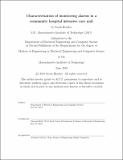Characterization of monitoring alarms in a community hospital intensive care unit
Author(s)
Hensley, Sarah (Sarah L.)
DownloadFull printable version (1.967Mb)
Other Contributors
Massachusetts Institute of Technology. Department of Electrical Engineering and Computer Science.
Advisor
Thomas Heldt.
Terms of use
Metadata
Show full item recordAbstract
Because the vast majority of monitoring alarms in the adult intensive care unit (ICU) do not require intervention, care providers are slow to respond to all alarms, endangering patients. We collect, characterize, and analyze alarms, alarm annotations provided by clinical staff while responding to alarms, and physiological data from a community hospital ICU. In order to suggest opportunities for suppressing irrelevant alarms, we examine monitoring device coverage across patients and analyze the alarms observed by device, priority, and type. On average, we observe 196.3 alarms per patient-day, for a total of 23,057 alarms. From these, the electrocardiogram and pulse plethysmogram produce 86.1% of all alarms. The lowest priority alarms represent 81.1% of all alarms, while the highest priority alarms compose just 5.5% of the total. While the rate of annotations is low, also just 5.5% of possible alarms, it is comparable to the rate of care provider interactions with alarms, as measured by alarm silencing, at 9.6%. Using these annotations, we find -- surprisingly -- that the annotated nuisance threshold-violation alarms tend to have higher excursions than actionable and advisory alarms, offering a statistic for separation. When focusing on threshold-crossing alarms, we find that 22.5% of Heart Rate Low alarms may actually indicate device error. Among ST segment alarms, 44.4% occur simultaneously with at least one other ST segment alarm, producing redundant alarms. Addressing these issues represent strategies for reducing excessive alarms in this community hospital cohort of ICU patients.
Description
Thesis: M. Eng., Massachusetts Institute of Technology, Department of Electrical Engineering and Computer Science, 2018. This electronic version was submitted by the student author. The certified thesis is available in the Institute Archives and Special Collections. Cataloged from student-submitted PDF version of thesis. Includes bibliographical references (pages 71-73).
Date issued
2018Department
Massachusetts Institute of Technology. Department of Electrical Engineering and Computer SciencePublisher
Massachusetts Institute of Technology
Keywords
Electrical Engineering and Computer Science.